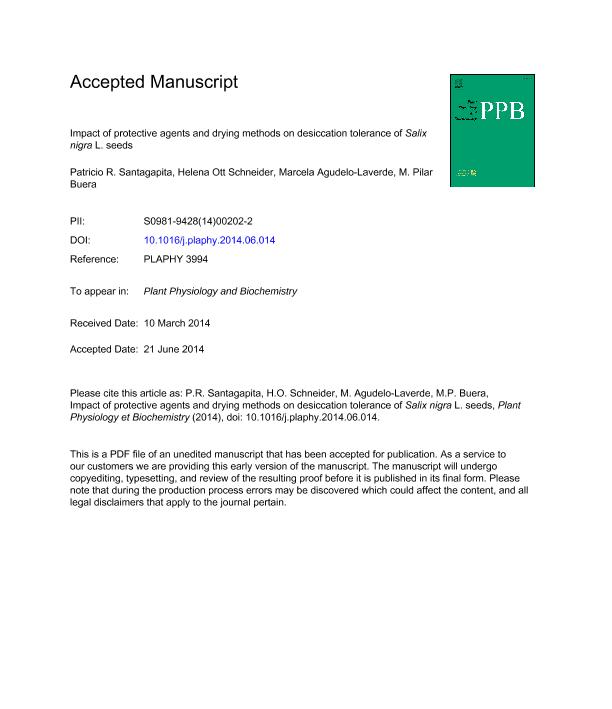Mostrar el registro sencillo del ítem
dc.contributor.author
Santagapita, Patricio Roman

dc.contributor.author
Ott Schneider, Helena
dc.contributor.author
Agudelo Laverde, Lina Marcela

dc.contributor.author
Buera, Maria del Pilar

dc.date.available
2019-09-24T20:20:40Z
dc.date.issued
2014-06
dc.identifier.citation
Santagapita, Patricio Roman; Ott Schneider, Helena; Agudelo Laverde, Lina Marcela; Buera, Maria del Pilar; Impact of protective agents and drying methods on desiccation tolerance of Salix nigra L. seeds; Elsevier France-editions Scientifiques Medicales Elsevier; Plant Physiology and Biochemistry; 82; 6-2014; 262-269
dc.identifier.issn
0981-9428
dc.identifier.uri
http://hdl.handle.net/11336/84336
dc.description.abstract
Willow seeds are classified as orthodox, but they show some recalcitrant characteristics, as they lose viability in a few weeks at room temperature. The aim of this work was to improve the desiccation tolerance of willow seeds (Salix nigra L.), as a model of sensitive materials to dehydration, through imbibition in solutions and later vacuum (VD) or freeze-drying (FD). Imbibition was conducted with 45% w/v trehalose or polyethylene glycol 400 -PEG- or water prior to dehydration treatments. Water- and especially trehalose-imbibed seeds subjected to VD showed better germination capability with respect to the freeze-dried ones. Water crystallization was mainly responsible for the great loss of capability germination observed in water- or trehalose-imbibed seeds subjected to FD. PEG behavior was better when seeds were FD instead of VD. DSC thermograms of seeds allowed to identify two thermal transitions corresponding to lipids melting and to proteins denaturation. This last transition reveals information about proteins state/functionality. Dehydration of control and PEG- or water-imbibed seeds affected proteins functionality leading to lower germinability. In the case of trehalose-imbibed seeds subjected to VD, proteins maintained their native state along dehydration, and the seeds showed a great germination capacity for all the water content range. Germinated seeds showed higher luminosity (L*), greenness (a*) and yellowness (b*) values than not-germinated seeds independently of the employed agent. Present work reveals that the presence of adequate protective agents as well the dehydration method were the main critical factors involved in willow seed desiccation tolerance.
dc.format
application/pdf
dc.language.iso
eng
dc.publisher
Elsevier France-editions Scientifiques Medicales Elsevier

dc.rights
info:eu-repo/semantics/openAccess
dc.rights.uri
https://creativecommons.org/licenses/by-nc-nd/2.5/ar/
dc.subject
COLOR CHANGES
dc.subject
DEHYDRATION
dc.subject
IMBIBITION
dc.subject
ORTHODOX SEEDS
dc.subject
SEED DESSICATION OLERANCE
dc.subject
SEED PROTEIN DENATURATION
dc.subject
TREHALOSE
dc.subject.classification
Otras Biotecnología Agropecuaria

dc.subject.classification
Biotecnología Agropecuaria

dc.subject.classification
CIENCIAS AGRÍCOLAS

dc.title
Impact of protective agents and drying methods on desiccation tolerance of Salix nigra L. seeds
dc.type
info:eu-repo/semantics/article
dc.type
info:ar-repo/semantics/artículo
dc.type
info:eu-repo/semantics/publishedVersion
dc.date.updated
2019-09-24T12:51:23Z
dc.journal.volume
82
dc.journal.pagination
262-269
dc.journal.pais
Francia

dc.journal.ciudad
Paris
dc.description.fil
Fil: Santagapita, Patricio Roman. Universidad de Buenos Aires. Facultad de Ciencias Exactas y Naturales. Departamento de Industrias; Argentina. Consejo Nacional de Investigaciones Científicas y Técnicas; Argentina
dc.description.fil
Fil: Ott Schneider, Helena. Universidad de Buenos Aires. Facultad de Ciencias Exactas y Naturales. Departamento de Industrias; Argentina
dc.description.fil
Fil: Agudelo Laverde, Lina Marcela. Consejo Nacional de Investigaciones Científicas y Técnicas; Argentina. Universidad de Buenos Aires. Facultad de Ciencias Exactas y Naturales. Departamento de Industrias; Argentina
dc.description.fil
Fil: Buera, Maria del Pilar. Consejo Nacional de Investigaciones Científicas y Técnicas; Argentina. Universidad de Buenos Aires. Facultad de Ciencias Exactas y Naturales. Departamento de Industrias; Argentina
dc.journal.title
Plant Physiology and Biochemistry

dc.relation.alternativeid
info:eu-repo/semantics/altIdentifier/url/http://www.sciencedirect.com/science/article/pii/S0981942814002022
dc.relation.alternativeid
info:eu-repo/semantics/altIdentifier/doi/http://dx.doi.org/10.1016/j.plaphy.2014.06.014
Archivos asociados
